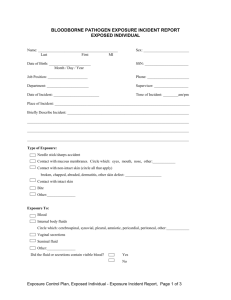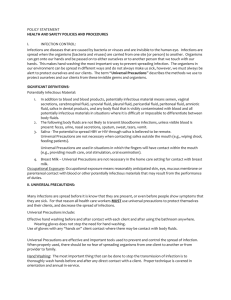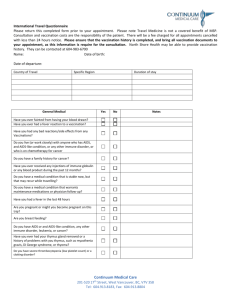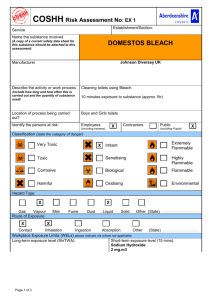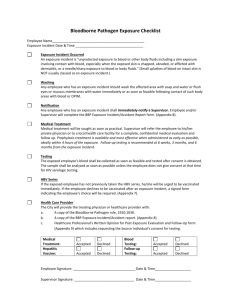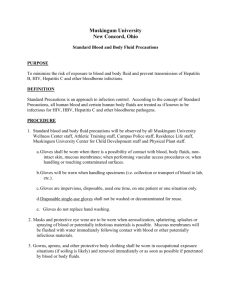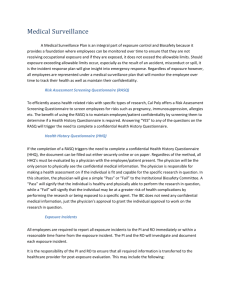infectious-disease
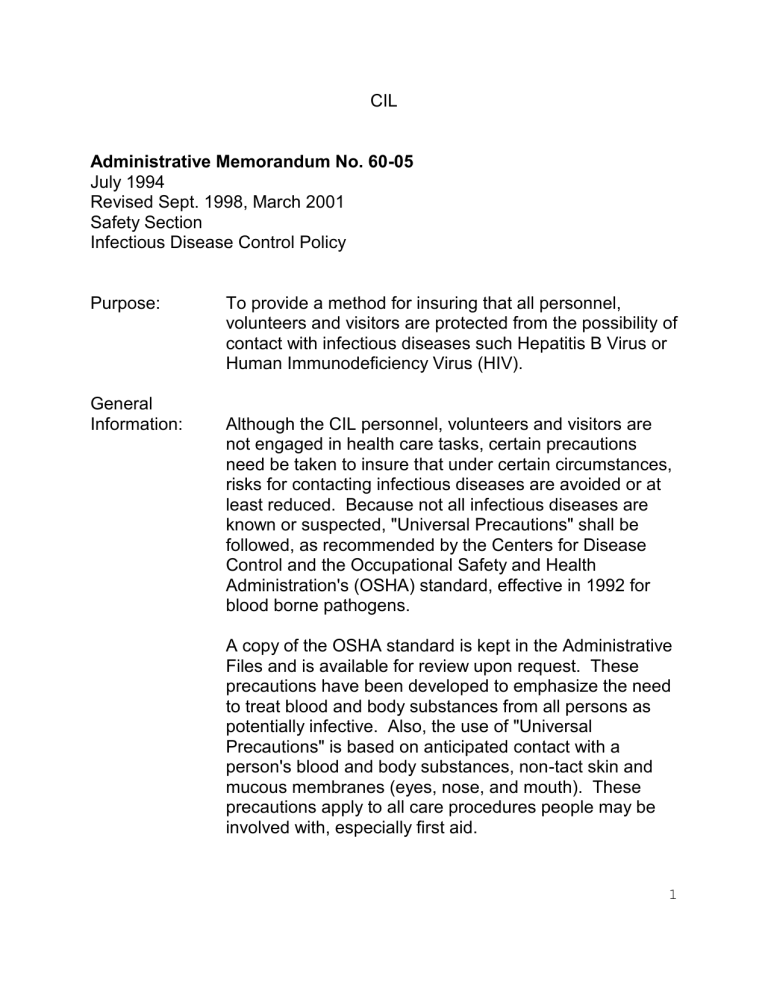
CIL
Administrative Memorandum No. 60-05
July 1994
Revised Sept. 1998, March 2001
Safety Section
Infectious Disease Control Policy
Purpose: To provide a method for insuring that all personnel, volunteers and visitors are protected from the possibility of contact with infectious diseases such Hepatitis B Virus or
Human Immunodeficiency Virus (HIV).
General
Information: Although the CIL personnel, volunteers and visitors are not engaged in health care tasks, certain precautions need be taken to insure that under certain circumstances, risks for contacting infectious diseases are avoided or at least reduced. Because not all infectious diseases are known or suspected, "Universal Precautions" shall be followed, as recommended by the Centers for Disease
Control and the Occupational Safety and Health
Administration's (OSHA) standard, effective in 1992 for blood borne pathogens.
A copy of the OSHA standard is kept in the Administrative
Files and is available for review upon request. These precautions have been developed to emphasize the need to treat blood and body substances from all persons as potentially infective. Also, the use of "Universal
Precautions" is based on anticipated contact with a person's blood and body substances, non-tact skin and mucous membranes (eyes, nose, and mouth). These precautions apply to all care procedures people may be involved with, especially first aid.
1
Procedures: A. PERSONAL PROTECTIVE EQUIPMENT
The use of Personal Protective Equipment (PPE) shall be a standard practice. The only justification for not using PPE is, when in the person's judgment, the use of PPE will pose an increased hazard to the person's own safety. If a person makes this judgment, the circumstances shall be investigated and documented in order to determine whether changes can be instituted to prevent such occurrences in the future.
1. GLOVES:
Wear gloves for anticipated contact with a person's mucous membranes, non-intact skin or moist body substances (e.g. blood, wound drainage, oral secretions, sputum, urine, and feces).
Handling items or surfaces soiled with blood or body substances; cleaning spills of blood or body substances.
Wear gloves if your hands have any open areas, cuts or abrasions.
If the glove you are wearing tears, wash hands immediately, wear a new glove as promptly as the situation warrants. Gloves should be changed after completing procedures in different body areas and after contact with the person being served. Disposable gloves shall not be washed or reuses. Said disposable gloves shall be kept in the rest room storage areas along with the First Aid Kit.
2. HAND WASHING:
2
Gloves may not provide complete protection.
Hands should be washed using an approved disinfectant kept on counters in the rest rooms, after gloves are removed. Ungloved hands and other surfaces shall be washed immediately and thoroughly if contaminated with blood or body substances. Always wash hands before and after contact with a person needing assistance.
3. SPILLS OF BLOOD/BODY SUBSTANCES:
Wear gloves during cleaning and decontaminating procedures. Use the before mentioned disinfectant or household bleach solution, 1/4 cup bleach in 1 gallon water for cleaning and decontaminating procedures.
4. WASTE:
Paper waste and contaminated gloves shall be disposed of in sealed bags and transported to the trash receptacle.
5. HEPATITIS B VACCINATION:
The CIL will keep on record information as to the availability of hepatitis B vaccination for any person who through an exposure incident comes in contact with another person's blood or body substance. Vaccinations will be offered within 24 hours of such an incident.
This is in accordance with OSHA supplement of instruction. The enforcement component of its Blood borne Pathogens regulation. (See
Attachment A for Hepatitis B Vaccination locations.)
3
B. EXPOSURE INCIDENT
An exposure incident is a specific eye, mouth or other mucous membrane, non-intact skin or parental contact with blood or other potentially infectious material that results from the performance of assistance to another person.
All exposure incidents shall be reported, investigated and documented. When an exposure incident occurs, it shall be reported to the
Administrative Assistant and Executive Director.
Following a report of an exposure incident, the exposed employee shall immediately receive a confidential medical evaluation and follow up, including at least the following elements:
1. Documentation of the route of exposure and circumstances under which the exposure incident occurred.
2. Identification and documentation of the source individual, unless it can be established that identification is infeasible or prohibited by law.
3. If feasible and/or consent is obtained, then the source individual's blood shall be tested to determine HBV and HIV. If consent is not given, the Executive Director shall establish that legally required consent cannot be obtained.
4. When the source individual is already known to be infected with HBV or HIV, testing for the source individual's known status need not be repeated.
4
5. Results of the source individual's testing shall be made available to the exposed person and that person shall be informed of applicable laws and regulations concerning disclosure of the identity and infectious status of the source individual. All persons who incur an exposure incident will be offered post-exposure evaluation and follow up in accordance with the OSHA standard.
C. INFORMATION PROVIDED TO THE HEALTH
CARE PROFESSIONAL
The Executive Director shall ensure that the health care professional responsible for the exposed person's Hepatitis B Vaccination is provided with the following:
1. A copy of 29 CFR 1910.1030;
2. A written description of the exposed person's duties as they relate to the exposure incident;
3. Written documentation of the route of exposure and circumstances under which exposure occurred;
4. Results of the source individual's testing, if available; and
5. All medical records relevant to the appropriate treatment of the exposed person including vaccination status.
D. HEALTH CARE PROFESSIONAL'S WRITTEN
OPINION
5
The Executive Director shall obtain and provide the exposed person with a copy of the evaluating health professional's written opinion within 15 days of the completion of the evaluation.
Such professionally written opinion shall be limited to whether HBV vaccination is indicated for the exposed individual and if the individual has received such vaccination; a statement for follow up including information that the exposed person has been informed about the evaluation and told the medical conditions resulting from exposure to blood or potentially infectious materials which require further evaluation and treatment. All other findings or diagnosis shall remain confidential and shall not he include in the written report.
E. MEDICAL RECORD KEEPING
The Administrative Assistant shall maintain medical records of the person exposed including the name and social security number of said person, a copy of the HBV vaccination status including the date of such vaccination, the results of examination, tests and follow up procedures, and all copies of materials prepared for the incident report. All such information shall be turned over to the local
Administrative Offices of Specialized Health
Services, Inc.
F. INFORMATION AND TRAINING
Training shall be provided for staff and volunteers on the agency's Infectious Disease Control Policy at least once each year. Training will include an interactive discussion of this Administrative Policy, a discussion of the epidemiology and symptoms of
6
blood borne diseases, and explanation of the modes of transmissions of blood borne pathogens, a recognition of tasks which may involve exposure, an explanation of the methods for reducing exposure through work practices and use of personal protective equipment (PPE), information for disposing contaminated materials, information of
Hepatitis B vaccination, description of emergency procedures, reporting methods, follow up procedures and any explanation of materials which require explanation regarding signs, labels and color coding. The ILC shall contract with other agencies, such as the Visiting Nurses Association and the County Health Department to conduct these trainings.
G. The Administrative Assistant shall maintain records of these training sessions including the date they were held, who was in attendance, and those who conducted the training as well as a copy of all handouts used.
H. All relevant records shall be made available to the person(s) involved in an exposure incident. All records shall also be made available on request to
OSHA. If the agency is closed, such records shall be disposition to the Director NIOSH.
1. There shall be an annual review and evaluation of the administrative memorandum conducted by the Executive Director.
_______________________________
Executive Director
7
